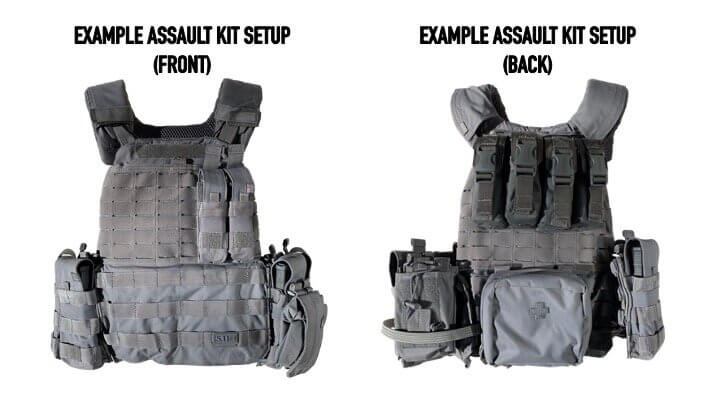First, there are no “right answers” when it comes to kit set-up. The critical factor is finding a set-up that is effective for you. What works for one person might not work for another. However, it can be helpful to share some general principles or specific tips when it comes to equipment set-up, since gear configuration is a never-ending process and there is always a way to make your kit layout function a bit better. Therefore, in this and future articles on CQB equipment, we suggest you take what works for you and leave the rest.
It is difficult to know if a specific kit layout works or doesn’t work if you do not put it to the test in realistic combat simulations. You may think your magazine pouches are positioned perfectly, only to realize that your magazines fall to the ground when you try to climb over a wall. This might not be important if your mission requirements almost never require you to climb over walls. However, in the more likely case that climbing and negotiating obstacles is an operational requirement for you, you must ensure your kit is configured for climbing. The same goes for crawling, moving through dense brush, water, mud etc. Fatigue is another important factor to consider. If moving long distances, at altitude or in extreme weather, a heavy and cumbersome kit might not be practical. Therefore, it is important to test your kit setup in the most realistic conditions possible. We will offer suggestions for how to do this in later articles and training materials.
A Simple Assault Kit Layout (Example Only) - Equipment from 5.11 Tactical and Blackhawk

While it can be tempting to decorate your plate carrier with all types of fancy pouches and accessories, this is rarely a wise choice in real combat operations.
As a rule of thumb, if you don’t really need something and never actually use it, take it off.
The vest/carrier in the picture is relatively slick with only pouches for 5 rifle magazines, 2 pistol magazines, 4 flashbangs, a radio, a medical pouch and a dump/utility pouch. You may need additional pouches for special equipment like knives, utility tools, lights, or batons etc. but some of this equipment can go on the belt or in other places too.
The bottom line is to keep your gear as minimalist as possible in terms of bulk and weight to maximize mobility and maneuverability.
While it might seem an obvious mistake, it is still common to see people place pouches on the firing shoulder. Practice shooting with both your primary and secondary weapons and transitioning between the two, ensuring that none of your equipment interferes with accurate shooting and smooth weapon manipulation.
Much of the equipment in this example comes with pull-tabs to make it easier to quickly access gear. This is important because your level of small motor skills and coordination will drop in a high-stress situation.
It might be easy to use your fingers to find, grip and manipulate a small zipper, clasp or button when you are unstressed in normal conditions. However, in a high-stress situation, in the cold, at night or in poor weather, you might not be able to find and manipulate small components on your equipment. This is why it can be useful to attach tabs, loops and grips on your pouches.
Even if your equipment already includes some of these, you might want to add to them to make them even easier to find under stress. Practice grabbing and pulling these under a variety of conditions and under stress if possible to make sure they work.
It is a good idea to be extra careful when it comes to retention of your weapons, ammunition and equipment, as long as it doesn’t make it overly difficult to access what you need.
An example of this is making sure there are extra cover flaps, retention bands or tiedowns on important pieces of equipment.
While open-top magazine pouches can make it easier for you to quickly reload, make sure to test these pouches rigorously to make sure that magazines won’t pop out when you are upside-down, or subjected to very intense motion or shock.
If you are hit by the shockwave from an explosion you don’t want all of your magazines to fly out. Adding some additional retention/safety measures to your pouches can help with this.
Depending on where you operate, you may be subjected to a variety of harsh environments and conditions. Consider this when setting up your gear.
For example, while Velcro is convenient and easy to manipulate, it will become less effective when caked with mud and dirt.
If you expect that you might become submerged in water, you will need to make sure that any non-waterproof equipment is protected accordingly.
If you are conducting air operations or have to move through dense brush or briars, you may need to pay special attention to loose straps that could become snagged.
In short, try to anticipate the worst-case scenario and think about how your kit will perform in those conditions. If possible, conduct field tests to verify assumptions.
While comfort might not seem to be a priority, discomfort will only add to your stress in combat. You should seek every advantage you can to make life easier, simpler and more comfortable.
The equipment in the example above is well-padded, smooth and ventilated.
If you have equipment that hurts, wears on you, rubs on you in uncomfortable ways or grows uncomfortable when you sweat, you can make modifications to your equipment by adding padding, cutting away excess materials, removing buckles and adding vents or breathable materials.
This brief article only covers some of the most basic and universal concepts in kit setup. In follow-on articles, we will discuss actual placement of the various pouches and equipment such as magazines, flashbangs, radio and medical pouch. There are pros and cons for each configuration and the ideal configuration will depend on your mission requirements and personal preferences.

